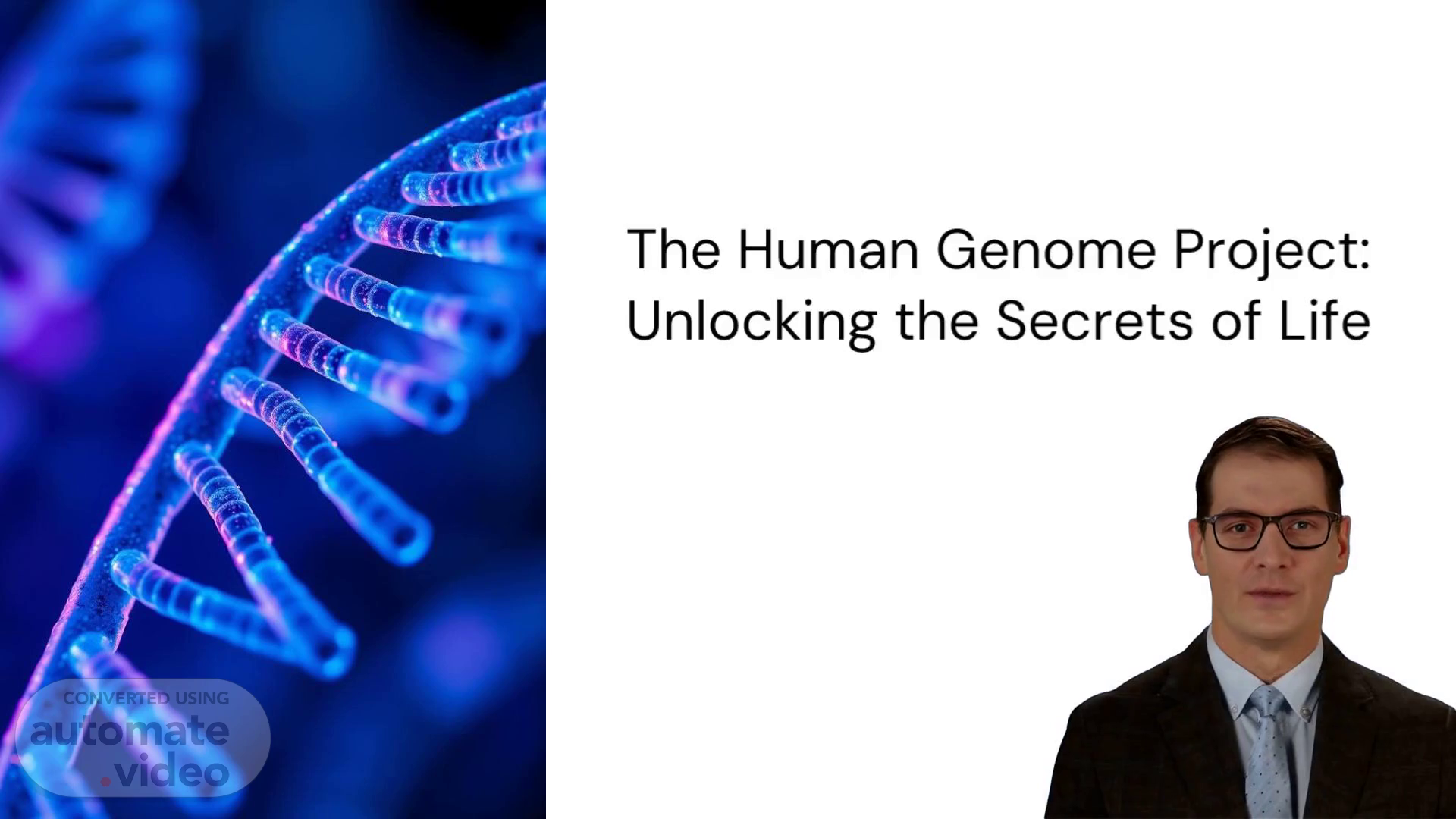Scene 1 (0s)
[Virtual Presenter] The Human Genome Project was a groundbreaking endeavor that brought together scientists from around the world to map and understand the complete human genetic code. This monumental task has opened doors to new discoveries in medicine, genetics, and our comprehension of biological processes..
Scene 2 (20s)
[Audio] The Human Genome Project was a comprehensive mapping effort. Its goal was to identify and map all the genes in human DNA, which consists of more than three billion base pairs. This massive undertaking drove significant technological advancements in DNA sequencing and computational tools..
Scene 3 (41s)
[Audio] Mapping the human genome has revolutionized our understanding of genetic disorders and enabled personalized therapies. This breakthrough has opened doors to more effective treatments and cures for diseases such as cancer, Alzheimer's, and Parkinson's. Furthermore, it has allowed us to develop targeted therapies tailored to individual patients' needs, leading to improved health outcomes and reduced side effects..
Scene 4 (1m 9s)
[Audio] The Human Genome Project was launched as an international scientific collaboration, marking a significant milestone in its journey. As the project progressed, it reached another major milestone when it was completed, with more than 99 percent of the genome sequenced to high accuracy. This achievement represents a major breakthrough in our understanding of human biology and opens up new possibilities for medical research and treatment.
Scene 5 (1m 37s)
[Audio] Sequencing the human genome consisted of two crucial steps. Firstly, researchers employed shotgun sequencing to divide the genome into smaller segments, sequence each segment, and subsequently reassemble the entire genome. This method permitted us to construct a detailed representation of the human genetic code. Secondly, advanced bioinformatics tools were developed to process, analyze, and interpret the enormous quantities of genomic data produced by this process. These technological advancements enabled scientists to discover novel insights into human biology and disease..
Scene 6 (2m 17s)
[Audio] Overcoming limitations in DNA sequencing technologies and computational power was a major challenge. Unraveling the intricate structure and function of the human genome required innovative approaches. These challenges were significant obstacles to achieving the goals of the project..
Scene 7 (2m 34s)
[Audio] Genetic diagnostics have been made possible by genome mapping, allowing us to develop genetic tests that identify disease risk and guide personalized treatments. This means that patients can receive targeted care based on their unique genetic profile. Furthermore, understanding the genetic basis of diseases has led to the development of more effective and tailored medications. These advances have the potential to significantly improve patient outcomes and quality of life..
Scene 8 (3m 7s)
[Audio] There are concerns about the potential misuse of genetic data, including the risk of genetic discrimination. This raises important questions about privacy and the responsible use of this sensitive information. Additionally, the project has sparked debates about the ethical boundaries of genetic manipulation and human enhancement, highlighting the need for careful consideration and regulation. Furthermore, ensuring equitable access to genetic technologies and therapies is crucial to ensure that these advancements benefit society as a whole, rather than exacerbating existing social and economic inequalities..
Scene 9 (3m 46s)
[Audio] As ongoing research utilizes genomic data to create more effective, tailored treatments and prevention methods, it enables us to better understand the complex interactions between genes, environment, and disease, ultimately leading to improved patient outcomes. Moreover, emerging technologies such as CRISPR have opened doors to direct DNA modification, offering new avenues for genetic engineering. Furthermore, genome analysis can provide valuable insights into human evolution, migration patterns, and ancestral relationships, shedding light on our shared history..
Scene 10 (4m 28s)
[Audio] The Human Genome Project has had a profound impact on our understanding of human biology. As we continue to analyze the vast amounts of genomic data generated by this project, we're uncovering new insights into the intricacies of human health and disease. Researchers are now using this knowledge to develop targeted treatments and preventive measures, revolutionizing the way we approach healthcare. Furthermore, the project's findings have also shed light on our evolutionary history, providing valuable clues about how humans came to be who we are. As we look back on the accomplishments of the Human Genome Project, it's clear that its legacy will continue to shape the course of scientific discovery for generations to come..
